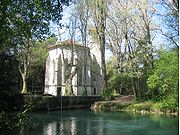Duino-Aurisina
| Duino-Aurisina Devin Nabrežina | ||
|---|---|---|
| Comune | ||
| Comune di Duino Aurisina / Občina Devin-Nabrežina | ||
 | ||
| ||
 Duino-Aurisina Location of Duino-Aurisina in Italy | ||
| Coordinates: 45°44′N 13°45′E / 45.733°N 13.750°ECoordinates: 45°44′N 13°45′E / 45.733°N 13.750°E | ||
| Country | Italy | |
| Region | Friuli – Venezia Giulia | |
| Province | Trieste (TS) | |
| Frazioni | See list | |
| Government | ||
| • Mayor | Vladimir Kukanja (Centre-Left) | |
| Area | ||
| • Total | 45.17 km2 (17.44 sq mi) | |
| Elevation | 144 m (472 ft) | |
| Population (31 May 2007) | ||
| • Total | 8,733 | |
| • Density | 190/km2 (500/sq mi) | |
| Demonym | Duinati (Devinčani), Aurisiniani (Nabrežinci) | |
| Time zone | CET (UTC+1) | |
| • Summer (DST) | CEST (UTC+2) | |
| Postal code | 34011 | |
| Dialing code | 040 | |
| Patron saint | Saint Roch | |
| Saint day | 16 August | |
| Website | Official website | |
Duino-Aurisina (Slovene: Devin-Nabrežina, German: Tybein-Nabreschin) is a comune (municipality) in the Province of Trieste in the Italian region of Friuli-Venezia Giulia. Lying near the border with Slovenia, it has a substantial Slovene population. It is named by the two major settlements, Duino (Devin) and Aurisina (Nabrežina).
Geography
The town lies on the Adriatic coast about 15 kilometres (9 mi) northwest of Trieste, on the border with Slovenia.
Duino-Aurisina borders the following municipalities: Komen (Slovenia), Doberdò del Lago, Monfalcone, Sežana (Slovenia), Sgonico, Trieste.
Famous residents
Slovene writer Alojz Rebula was born in San Pelagio, while the Slovene poet Igo Gruden was born in Aurisina. The Slovenian economist Ivan Ples was born in Duino, where the composer Andrej Volarič also lived.
The poet Rainer Maria Rilke began his Duino Elegies while staying at Duino castle in 1912.
The physicist Ludwig Eduard Boltzmann spent his last year, 1906 in Duino.
Parishes
The municipality of Duino-Aurisina contains the frazioni (subdivisions, mainly villages and hamlets). This list shows Italian names with Slovene names in brackets: Aurisina (until the rise of fascism Nabresina) (Nabrežina), Ceroglie (Cerovlje), Duino (Devin), Malchina (Mavhinje), Medeazza (Medja vas), Precenico (Prečnik), Prepotto (Praprot), San Pelagio (Šempolaj), San Giovanni di Duino (Štivan), Sistiana (Sesljan), Slivia (Slivno), Ternova Piccola (Trnovca), Villaggio del Pescatore (Ribiško naselje), Visogliano (Vižovlje), Aurisina S. Croce (Nabrežina Križ), Aurisina Cave (Nabrežina Kamnolomi), Aurisina Stazione (Nabrežina Postaja) and Aurisina Centro (Nabrežina).
Demographic evolution
As of 31 December 2004, it had a population of 8,815 and an area of 45.2 km². According to the 1971 census, 37,5% of the population (mainly in and around Aurisina) belongs to the Slovene ethnic group and about 60% to the Italian ethnic group (mainly in Duino and Sistiana) [1]

Gallery
-
Fauntain and castle Duino
-
Peninsula near old castle Duino
-

The Dama Bianca
-
Timava river near Golfo di Panzano at San Giovanni di Duino
Twin towns
See also
References
External links
![]() Media related to Duino-Aurisina at Wikimedia Commons
Media related to Duino-Aurisina at Wikimedia Commons



